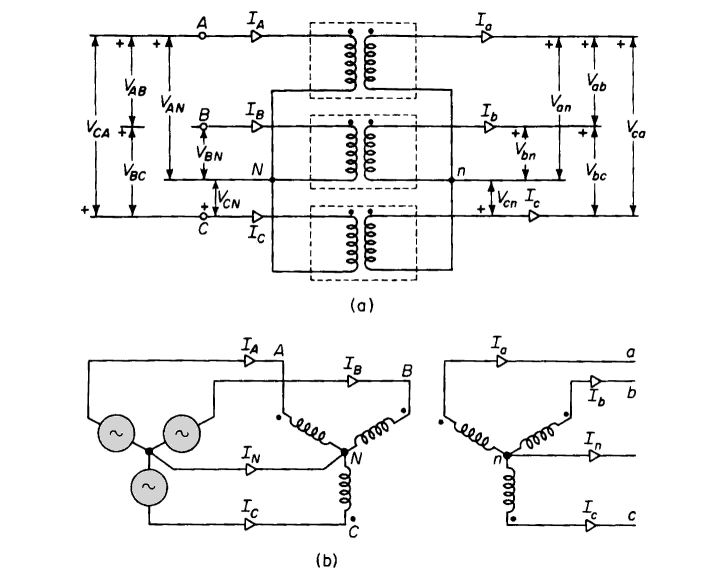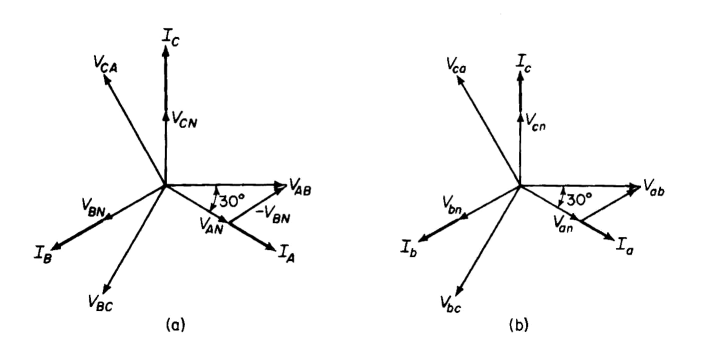| Capacitors, Magnetic Circuits, and Transformers is a free introductory textbook on the physics of capacitors, coils, and transformers. See the editorial for more information.... |

|

Home  The Transformer The Transformer  3-Phase Transformer Connections 3-Phase Transformer Connections  Wye-Wye Connection Wye-Wye Connection |
|||||||||||||||
| See also: Delta-Delta Connection, Wye-Delta Connection, Open-Delta or V-V Connection | |||||||||||||||






|
|||||||||||||||
Wye-Wye Connection
Three single-phase transformers with their primaries and secondaries both connected in wye are shown in Figs. 6-23(a) and 6-23(b). The primary neutral is shown connected to the neutral of the source and the secondary neutral connected to that coming from the load. In many applications the neutral connection consists of ground. Connecting the primary neutral to the neutral of source assures balanced line-to-neutral voltage even if the load is unbalanced or if the transformers have unequal exciting admittances. The equivalent circuits of Fig. 6-11, 6-13, and 6-14 apply to each of the three transformers connected wye-wye with or without the ideal transformer just as they do in the delta-delta arrangement. Here also, if the transformers are identical and supply balanced 3-phase load, each transformer carries one-third of the 3-phase load. It can be seen from Fig. 6-23 that the current in the transformer winding is the line current in the wye connection. The secondary currents Ia, Ib, and Ic are therefore practically in phase with the primary currents IA, IB, and IC and if the exciting current is neglected, the current ratios are the reciprocals of the turns ratio, i.e.
Also, if the leakage impedance is neglected, the voltage ratios equal the turns ratios, thus
Phasor diagrams are shown for the wye-wye arrangement in Fig. 6-24. The wye connection is generally used in high-voltage applications because
the voltage across the transformer winding is only 1/
and
from which
Similarly
and
The wye-wye arrangement requires a neutral connection between the source and the primary of the transformers not only to assure balanced line-to-neutral voltage, but also to provide a path for the third-harmonic component in the exciting current of the transformers. Without the primary neutral connection, serious unbalances in the line-neutral voltage may result from (a) unequal exciting admittances among the three transformers and (b) unbalanced line-to-neutral loads in the secondary. Furthermore, if the third harmonics are suppressed in the exciting current, large third harmonic components may appear in the line-to-neutral voltages. The wye-wye arrangement is, therefore, a four-wire system if balanced voltages are to be assured. The delta-delta arrangement is, on the other hand, a 3-wire system.
|
|||||||||||||||
Home  The Transformer The Transformer  3-Phase Transformer Connections 3-Phase Transformer Connections  Wye-Wye Connection Wye-Wye Connection |
|||||||||||||||
Last Update: 2011-02-16






 or 0.58 of the line-to-line voltage, which follows from Fig. 6-23 and the phasor diagrams in Fig. 6-24 as shown below
or 0.58 of the line-to-line voltage, which follows from Fig. 6-23 and the phasor diagrams in Fig. 6-24 as shown below




